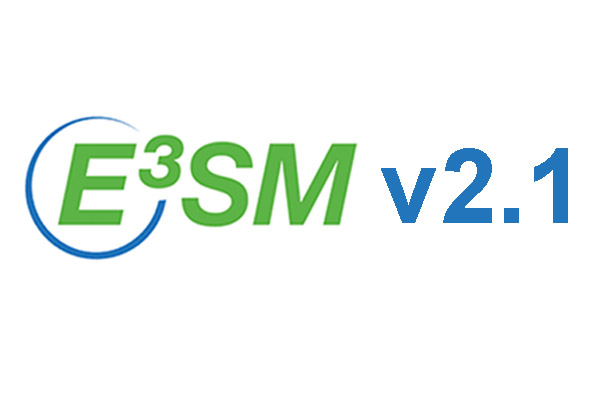E3SM Tagged v2.1, v3 is Next
The E3SM Project has tagged the E3SM version 2.1 of its source code on January 12th, 2023. This is technically a minor release compared to version 2.0 but has a substantial improvement, namely stronger Atlantic Meridional Overturning Circulation (AMOC), smaller regional sea surface temperature (SST), and smaller sea-ice biases. The AMOC bias reduction was the outcome of the several months long, intense and focused working group, led by Luke Van Roekel, and created specifically for the purpose of improving AMOC. The solution was the addition of the submesoscale eddy parameterization for the ocean, which resulted in around a 2.5 Sv increase in the AMOC, with AMOC streamfunction value of 11-12 Sv (at 26.5°N below 500 m depth in the standard ~1-degree resolution E3SM model; note that the coupled high-resolution simulations did not have an unacceptably weak AMOC). The hypothesis explaining this improvement is that the parameterization improved near-surface stratification which improved the distribution of Arctic sea ice. This in turn resulted in less freshwater input to the surface ocean, improving the AMOC. These changes in v2.1 moved E3SM from being an outlier in terms of AMOC to being within the envelope of CMIP6 models. It is a major improvement over the v1 releases and v2.0 in E3SM.
The sea ice model (MPAS Sea Ice) has also had an update that will change climate compared to v2.0, with a correction to how shortwave parameters are interpolated in the SNICAR-AD 5-band radiation scheme.
There have been only a few changes to the E3SM Atmosphere Model (EAM) and they do not affect the climate of the base watercycle configuration. The Semi-Lagrangian transport scheme introduced in v2.0 was updated to support GPUs and the new C++ version of the atmosphere model being developed for version 4 (now called “EAMxx”, formerly known as “SCREAM”). There is a new “cold point parabola” method for finding the tropopause, and the atmosphere model restored the ability to run the atmosphere with ideal physics.
There have been no major changes to the default version of the E3SM Land Model (ELM) but several features included in 2.1 (but turned off) are being evaluated for inclusion in version 3. These include: implementation of topography-based subgrid structure (“topounits”) and accompanying parameterizations and atmospheric forcing downscaling methods; a new plant hydraulics scheme; two-way land-river hydrological coupling through the infiltration of floodplain water; an implementation of perennial crops; updates to the SNICAR-AD snow radiative transfer model; and implementation of soil erosion and sediment yield in ELM-Erosion.
Similarly, the river model, MOSART, has no changes to its default configuration but a major new optional feature included in 2.1, two-way river-ocean hydrological coupling between MOSART and MPAS-O, is being tested for version 3.
Several components had updates to support future biogeochemistry simulations. (No BGC simulations were done with 2.0). There is now a carbon budget calculated within each component and the coupler. The sea-ice updated its default sea ice biogeochemistry namelist parameters to be consistent with version 2.0 improvements to nitrogen cycling and corrected the ice-ocean dissolved organic nitrogen coupling.
Given the changes to the ocean and sea-ice, new coupled simulations have been performed with 2.1. The E3SM Phase 3 Coupled Group lead Chris Golaz explained that since both E3SMv1 and v2.0 suffered from a weak AMOC, the project decided to perform a new simulation campaign with v2.1 consisting of the DECK (piControl, abrupt-4xCO2, 1pctCO2) and a five-member historical ensembles. These simulations show a significant improvement in the strength of the AMOC as well as reductions in regional SST and sea-ice biases. A paper is in preparation to describe how the climate changes compared to v2.0.
The project has created a maintenance branch in its repository for version 2.1, called “maint-2.1”, which will continue to receive machine updates and important bug fixes. E3SM users should check out that branch if they wish to try running this version. The main development branch of the model will now start to receive changes for version 3 and the simulated climate from the main branch will be unvalidated until version 3 is finalized later this year. Users should avoid using main repository branch until that time.
Resources
- E3SM v2.1 DOI:10.11578/E3SM/dc.20230110.5
- GitHub tag: Release E3SM v2.1.0 E3SM-Project/E3SM
This article is a part of the E3SM “Floating Points” Newsletter, to read the full Newsletter check:



